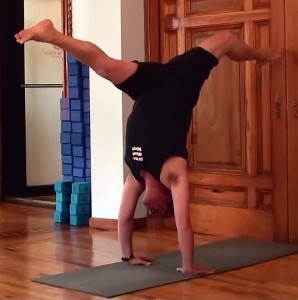Hanumanasana or forward split has been my favorite yoga pose since the day I started practicing. I have stupidly long hamstrings and equally open hips so I was basically born to do this stretch.
The psoas and iliacus are together called the iliopsoas because they meet and form a common tendon that connects to a knob of bone called the lesser trochanter. The iliacus goes from the lesser trochanter to wrap the inside of the hip or bowl of the pelvis, while the psoas rises up to attach along the lumbar spine.
Almost every psoas stretch is also an iliacus stretch by dint of their mutual attachment at the inner thigh. Along with my loose hamstrings I have very long psoas muscles and don’t often feel the psoas and iliacus when doing conventional stretches of these muscles.
But when I do a handstand and work my split while upside down I can get an extremely sensational stretch of both the psoas and iliacus muscles. The key to getting the deepest stretch in this position is to square the hips as much as you can while separating the legs as far apart as possible. As well as engaging the abdominals to the best of your ability.
There are two important factors to be aware of.
1) If you usually work near the wall for your handstand practice it can be scary to move so far into the middle of the room and trust that the wall will catch you.
2) It can be hard to feel where the legs are when you are upside down and it might take a number of attempts before you can either get the legs to fully separate or get the feet to lower to similar levels. The foot on the wall tends to be lower than the foot towards the middle of the room.
Psoas And Iliacus Stretch: Handstand Split
•You can eyeball the distance that the hand should be from the wall or set up with your hands a legs length away.
•Starting from downward dog lightly kick up and bring one leg to the wall. This is the scary part and you have to trust that your leg will touch the wall and you won’t collapse in a heap.
•Once one foot is on the wall extend the other leg towards the middle of the room. Try and keep the feet at the same height which is often hard to feel when you are upside down.
•The psoas stretch comes in the squaring of the hips. It is always easier to let the hips turn open. Keep trying to pull turn the pelvis so that the outer hips are on the same plane. The more you can do this and engage the abdominals the more the psoas will stretch.

